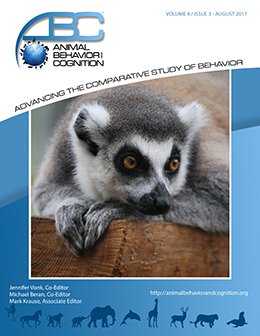Vol 4, Issue 3, August 2017
World in Motion: Perception and Discrimination of Movement in Juvenile Grey Bamboo Sharks (Chiloscyllium griseum)
Citation
Fuss, T., Russnak, V., Stehr, K., & Schluessel, V. (2017). World in motion: Perception and discrimination of movement in juvenile grey bamboo sharks (Chiloscyllium griseum). Animal Behavior and Cognition, 4(3), 223-241. https://doi.org/10.26451/abc.04.03.03.2017
Abstract
The aim of the present study was to test juvenile grey bamboo sharks (Chiloscyllium griseum) for their ability to perceive and discriminate simple and complex motion patterns. Experiments were carried out as two-alternative forced choice experiments; choosing the designated positive stimulus was rewarded with food. Individuals were first trained to differentiate between two videos of circles moving at different velocities surrounded by squared reference frames. All tasks were successfully mastered within 3–30 training sessions. Transfer tests revealed whether the training stimulus was still successfully detected if velocity or direction of movement were changed. In a second task, individuals were presented with more complex motion patterns in form of videos of different organisms such as eel vs. trout, eagle vs. bat and dolphin vs. shark. A series of transfer tests elucidated whether sharks could still recognize these stimuli when shown (a) without a reference frame, (b) from a different perspective (front or sideways), (c) enlarged or downsized or (d) as point displays (PDs). Results were rather surprising, as sharks discriminated easily between circles moving in different directions as well as between differently moving organisms but failed in two out of three experiments to apply the acquired information to new situations as provided by transfer tests. Nonetheless, PD videos of ‘eel’ and ‘trout’ were recognized by all sharks (N = 7), suggesting that the ability to spontaneously recognize an organism based on its biological motion alone is present in elasmobranchs.
